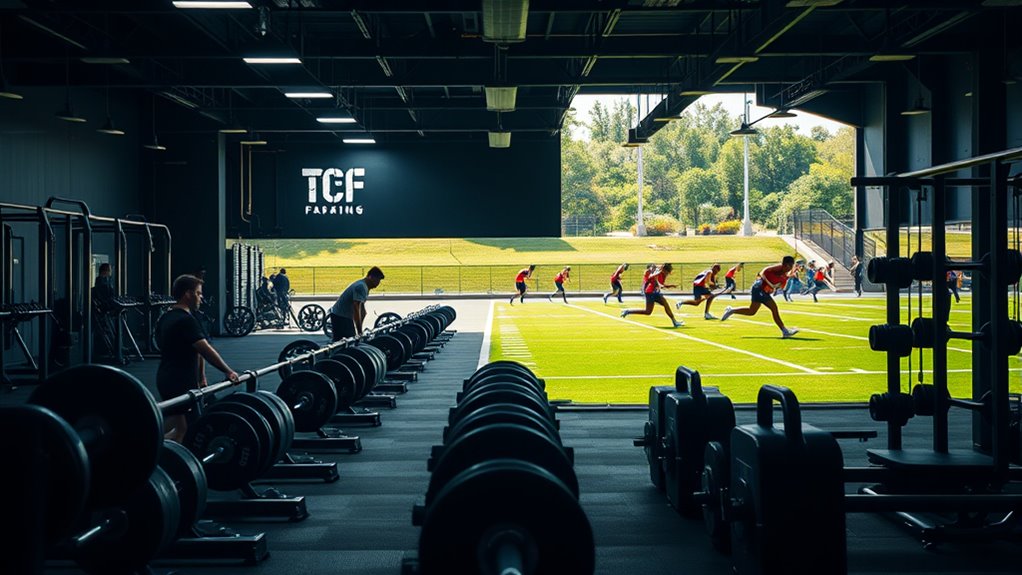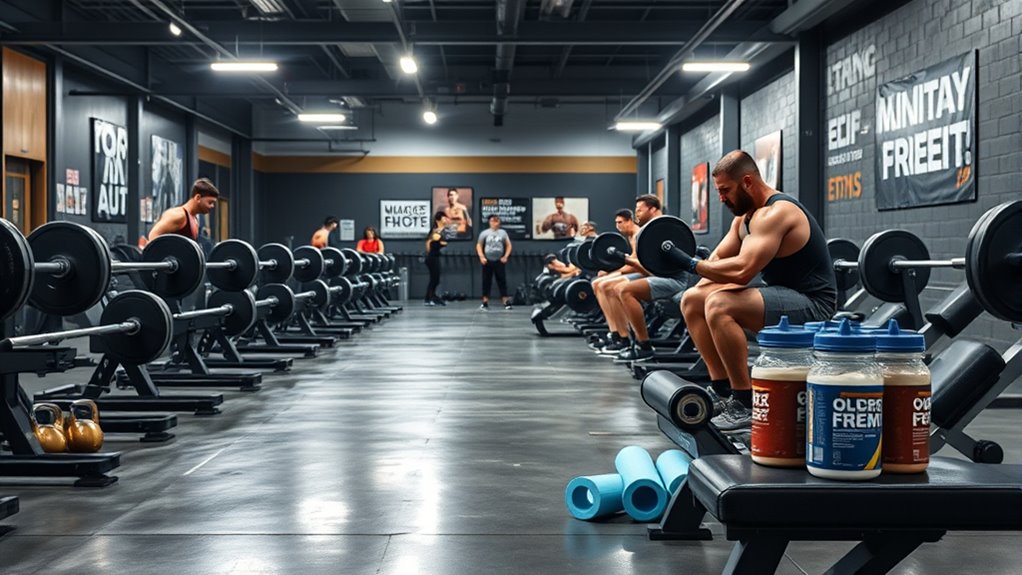To transfer gym gains to the field, focus on sport-specific strength training that targets key muscle groups and movement patterns. Incorporate explosive plyometric drills, prioritize mobility and flexibility, and balance strength with endurance. Structure your routines to progressively challenge yourself, ensuring proper recovery and injury prevention. By aligning your workouts with your sport’s demands, you’ll boost performance and resilience. Keep exploring further for detailed strategies to optimize your training and game-day results.
Key Takeaways
- Conduct sport-specific assessments to identify key muscle groups and movement patterns for targeted training.
- Design routines combining compound lifts, plyometrics, and core stability exercises aligned with sport demands.
- Incorporate plyometric drills to develop explosive power and reaction time essential for field performance.
- Prioritize mobility, flexibility, and recovery to enhance movement efficiency and prevent injuries during transition from weight room to field.
- Balance strength with endurance training to ensure sustained athletic performance and optimize overall fitness levels.
Assessing Your Sport-Specific Strength Needs

Before designing a strength training program, understanding the specific physical demands of your sport is essential. Conducting a sport-specific analysis helps identify the key muscle groups and movement patterns fundamental for your performance. This analysis guarantees that your training targets the muscles involved in your sport, maximizing skill transfer. For example, a basketball player needs explosive leg power, while a swimmer focuses on shoulder stability and core strength. By pinpointing these needs, you can tailor exercises that directly improve on-field performance. Ignoring these specifics might lead to wasted effort or imbalanced development. Remember, a focused assessment aligns your strength training with your sport’s unique demands, making your training more effective and efficient. Incorporating specific injury prevention strategies during your assessment can also help reduce the risk of common sport-related injuries. This foundation is imperative before progressing to routine design.
Designing an Effective Resistance Training Routine

Creating an effective resistance training routine involves selecting exercises and structuring workouts that align with your sport-specific needs and goals. Focus on exercises that build core stability, essential for maintaining balance and preventing injuries during play. Incorporate movements that challenge your mental toughness, pushing you past comfort zones. To visualize, imagine this table:
| Exercise Type | Focus Area |
|---|---|
| Compound lifts | Overall strength |
| Core stability drills | Balance and injury prevention |
| Functional movements | Sport-specific skills |
Design your routine to progressively increase intensity, ensuring consistent gains. Balance strength work with mental resilience, so you’re prepared physically and mentally for game-day pressures. This strategic approach keeps you sharp, durable, and ready for every challenge. Additionally, incorporating performance upgrades from Mazda tuning can serve as a metaphor for making strategic improvements to your training program to optimize results.
Incorporating Plyometrics for Explosive Power

Have you ever wondered how athletes generate sudden bursts of speed and power? Plyometric techniques are essential for developing explosive power needed on the field. Incorporate explosive drills like box jumps, squat jumps, and bounding exercises into your training to enhance muscle elasticity and reaction time. These drills train your muscles to contract quickly, improving overall explosiveness. When performed with proper form and intensity, plyometrics can substantially boost your ability to accelerate, jump higher, and change direction swiftly. Start with low-impact exercises and gradually increase intensity to avoid injury. Incorporating proper technique and understanding how to perform these drills safely is crucial for maximizing benefits and minimizing risks. Consistent plyometric training complements your resistance routine, ensuring you develop the fast-twitch muscle fibers vital for explosive movements during gameplay. Remember, quality over quantity is key to maximizing benefits and preventing setbacks.
Prioritizing Mobility and Flexibility for Performance and Injury Prevention

Wondering how to boost your athletic performance and reduce injury risk? Prioritizing mobility and flexibility is key. Start each session with dynamic stretching to warm up muscles and improve range of motion, which prepares your body for intense activity. Incorporate foam rolling into your routine to release muscle tension and increase blood flow, helping prevent injuries caused by tightness or imbalance. Consistent flexibility work enhances movement efficiency, allowing you to perform better on the field. Remember, a well-rounded approach includes not just strength but also maintaining your body’s mobility. By dedicating time to these practices, you’ll not only elevate your performance but also build resilience against common sports injuries. Incorporating proper recovery techniques can further optimize your progress and prevent setbacks. Mobility and flexibility are foundational for sustained, high-level athletic achievement.
Balancing Strength and Endurance for Optimal Results

Achieving peak athletic performance requires a careful balance between strength and endurance training, as both are essential for different aspects of physical capability. To optimize results, focus on muscle hypertrophy through targeted strength exercises that build power and size. Simultaneously, incorporate cardiovascular conditioning to enhance stamina and recovery. Balancing these elements prevents overtraining and guarantees you develop both raw strength and endurance. Prioritize strength sessions that challenge your muscles, while maintaining regular cardio workouts to improve your cardiovascular system. This approach helps you perform consistently on the field, with the endurance to sustain effort and the strength to dominate physically. Keep your training varied and strategic, so you build a well-rounded foundation for peak performance. Understanding the importance of balanced training ensures you achieve optimal results without risking burnout or injury.
Monitoring Progress and Adjusting Your Program

To guarantee your strength training program stays effective, you need to regularly monitor your progress and make adjustments as needed. Track performance metrics like max lifts, reps, and overall strength gains to see if you’re progressing. Pay close attention to injury indicators such as persistent soreness, joint pain, or fatigue, which could signal overtraining or improper form. If performance metrics plateau or decline, it’s time to modify your routine—perhaps increasing rest, adjusting weights, or changing exercises. Consistent assessment helps you stay on track and prevent injuries that could set you back. Remember, sound healing science and adaptability are key; staying vigilant about your progress and injury signs ensures your program remains effective and safe, leading to steady improvements and long-term gains.
Nutrition and Recovery Strategies for Athletic Gains

Enhancing your nutrition and recovery strategies is essential for maximizing athletic gains. Focus on hydration strategies by drinking water consistently throughout the day, especially around workouts, to maintain peak performance and prevent fatigue. Incorporate nutrient-dense foods that support muscle repair and energy replenishment, such as lean proteins, complex carbs, and healthy fats. Sleep enhancement is equally critical; prioritize consistent sleep schedules and aim for 7-9 hours nightly to facilitate recovery, hormone regulation, and muscle growth. Proper nutrition fuels your workouts, while effective recovery allows your body to adapt and improve. Don’t overlook the importance of hydration and sleep—integrating these elements ensures you’re ready to perform at your best and see steady progress in your athletic journey. Additionally, understanding high refresh rates in visual equipment can help optimize your environment for focus and relaxation during recovery periods.
Frequently Asked Questions
How Often Should I Update My Training Program?
You should update your training program based on your progress and goals. Generally, adjusting every 4 to 6 weeks works well for most athletes. Focus on progression planning by increasing intensity, volume, or complexity gradually. Keep track of your performance and recovery, and if you hit a plateau or feel fatigued, it’s time for a tweak. Regular updates guarantee continuous improvements and prevent plateaus.
What Are Common Mistakes to Avoid During Strength Training?
When you’re strength training, avoid common mistakes like neglecting proper form, which can lead to injuries. Don’t forget to incorporate progressive overload gradually; pushing too hard too fast can cause setbacks. Focus on consistency and listening to your body. Skipping warm-ups or overtraining are also pitfalls. By maintaining proper form and steadily increasing effort, you’ll maximize gains and stay safe during your training journey.
How Do I Prevent Overtraining and Burnout?
Like a well-crafted symphony, your training needs balance to avoid overtraining and burnout. You should prioritize recovery strategies such as rest days, sleep, and proper nutrition. Incorporate stress management techniques like mindfulness or deep breathing. Listen to your body—if you feel persistent fatigue or soreness, ease up. Staying mindful of these practices safeguards you maintain progress without risking injury or exhaustion, keeping you sharp and ready for the field.
Which Supplements Support Athletic Performance Safely?
When considering supplements to support athletic performance, focus on safe, evidence-based options. Nutritional supplements like creatine, beta-alanine, and caffeine can act as performance boosters if used appropriately. Always consult with a healthcare professional before adding new supplements to your routine. Stick to reputable brands, follow recommended dosages, and prioritize a balanced diet. These steps help enhance your performance safely without risking overtraining or burnout.
How Can Mental Toughness Be Integrated Into Training?
You’ve got to keep your eye on the prize, so integrating mental toughness is key. Focus on building mental resilience through visualization techniques that prepare you for game-day pressures. Practice positive self-talk and simulate high-stakes scenarios during training to strengthen your mind. These strategies help you stay calm under pressure and perform at your best, turning mental toughness into second nature and giving you an edge when it counts most.
Conclusion
Remember, building strength isn’t just about lifting heavy—it’s about training smart and tailored to your sport. Incorporating varied methods like plyometrics and mobility work can boost explosiveness and prevent injuries. Some believe that more training always equals better results, but evidence shows recovery and proper nutrition are just as essential. Stay consistent, listen to your body, and adjust your program as you progress. Your dedication and smart planning will truly take your game from the weight room to the field.









